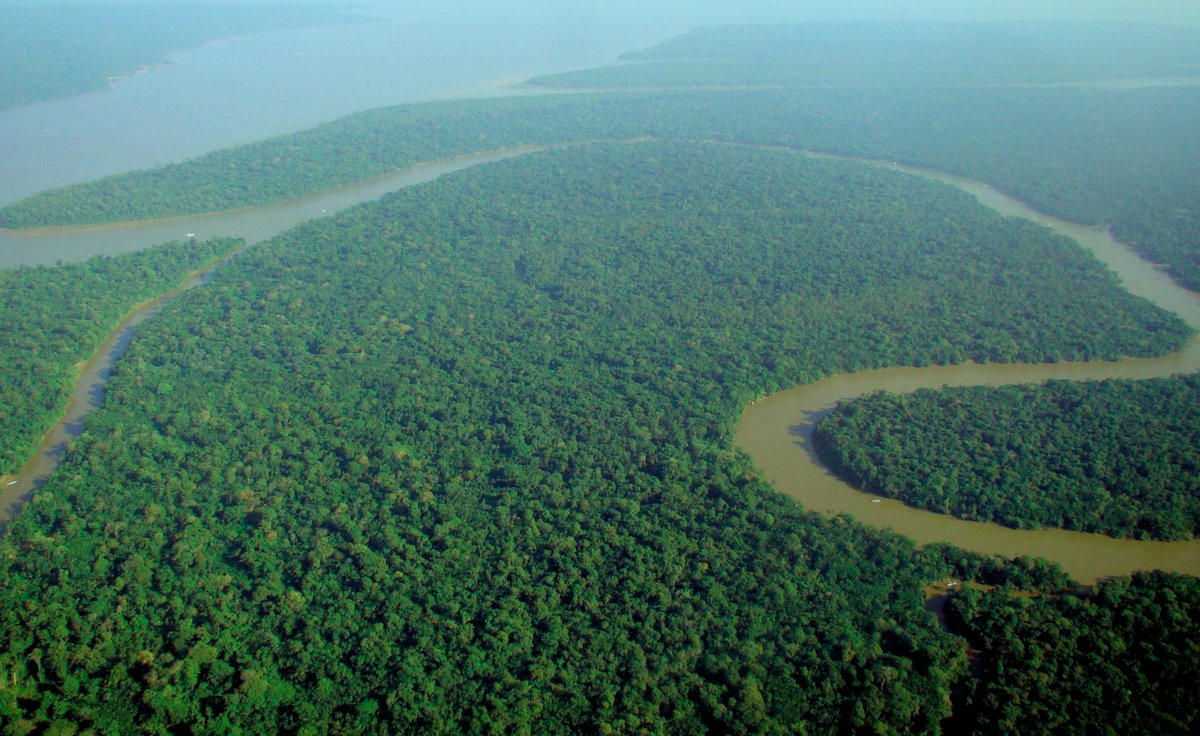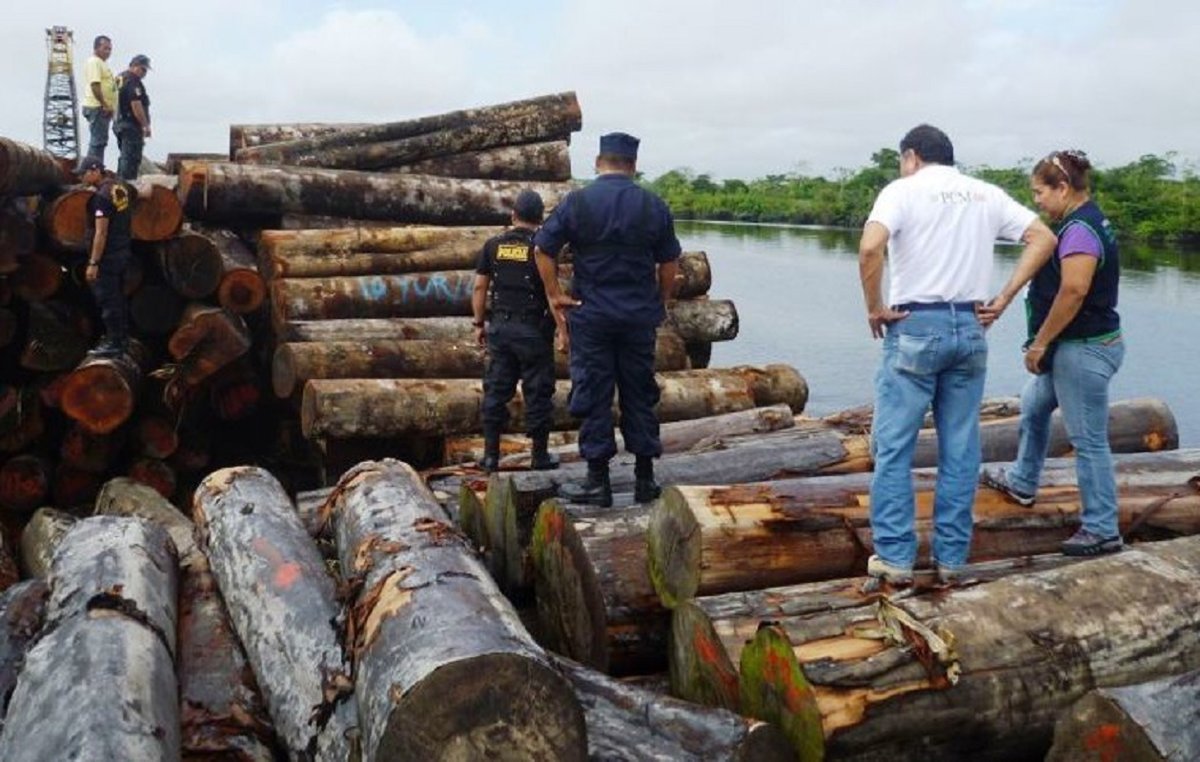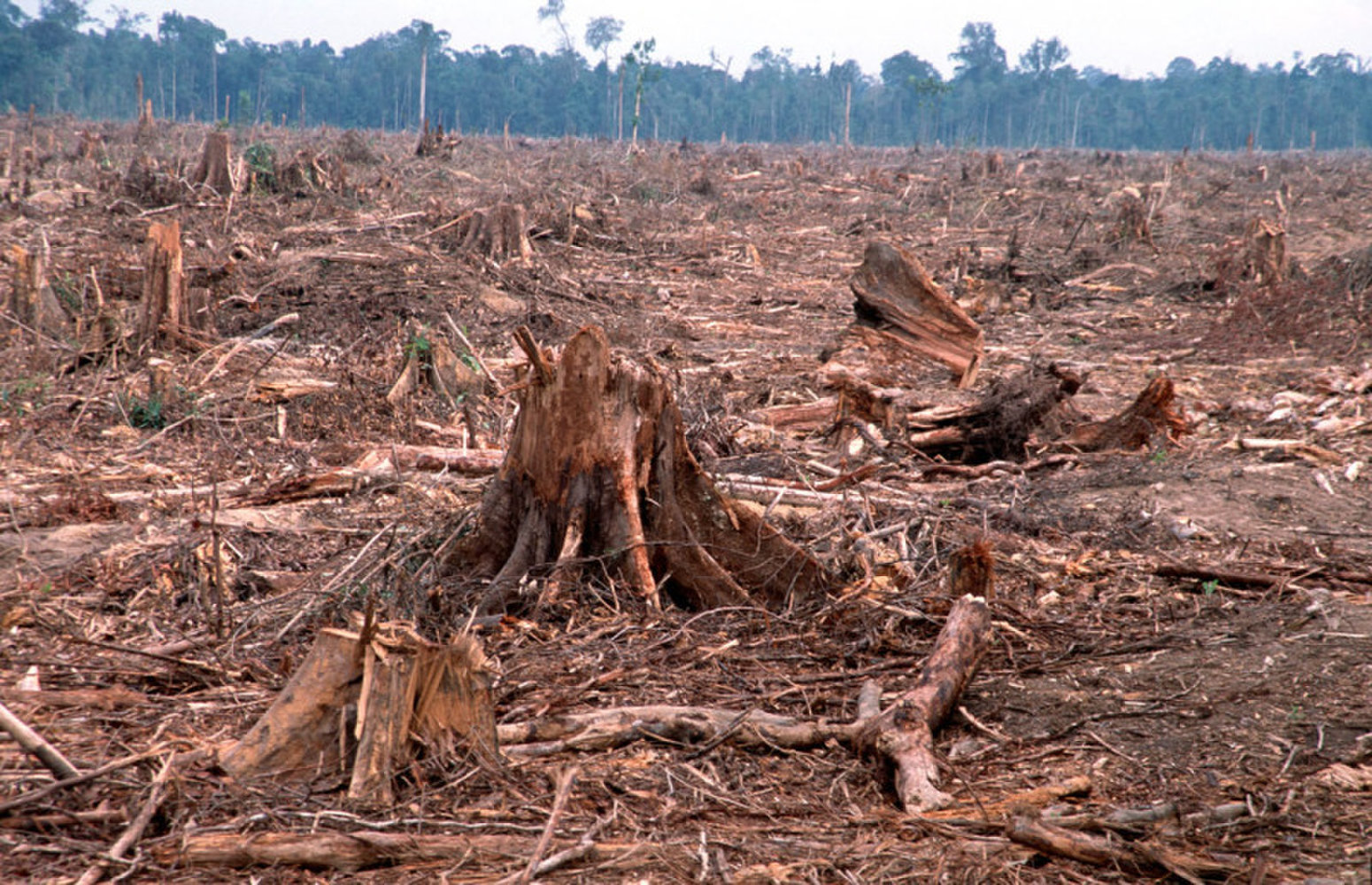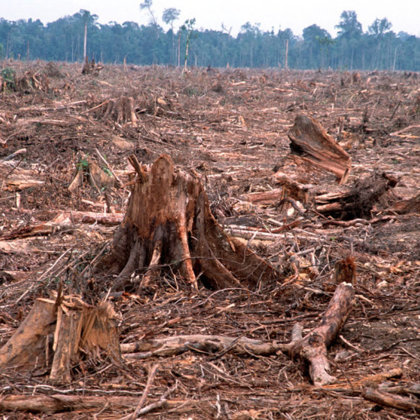DEFORESTATION, IS THE PERMANENT DESTRUCTION OF FORESTS IN ORDER TO MAKE THE LAND AVAILABLE FOR OTHER USES,CLEARANCE ,CLEAR CUTTING IS THE REMOVAL OF A FOREST FROM LAND WHICH IS THEN CONVERTED TO A NON FOREST USE.DESTROY EQUIPMENT USE BY ILLEGAL MINERS,THE DAMAGE TO THE NATURE IS SO TERRIBLE THAT ALL THE WATER IS POISONED.HOW TO STOP DEFORESTATION? DEFORESTATION ALSO CONTRIBUTES TO AIR AND WATER POLLUTION,A LOSS OF BIODIVERSITY,EROSION AND CLIMATE DISRUPTION.
 It is the world’s largest tropical rainforest, also known as Amazonia or Amazon Jungle. It has an area of 5,500,000
km2 and covers most of the Amazon Basin of South America and runs
through Brazil, Peru, Colombia, Venezuela, Ecuador, Bolivia, Guyana,
Suriname, and French Guiana. The Amazon River also runs through the
forest. About 60 percent of the forest is contained in Brazil.The forest is found in Asia covering Indonesia, Laos, Cambodia, and the Malay Peninsula. It once covered even a greater area in Asia but deforestation destroyed most regions of the rainforest. The forest is home to many rare birds, mammals, amphibians, and reptiles.
It is the world’s largest tropical rainforest, also known as Amazonia or Amazon Jungle. It has an area of 5,500,000
km2 and covers most of the Amazon Basin of South America and runs
through Brazil, Peru, Colombia, Venezuela, Ecuador, Bolivia, Guyana,
Suriname, and French Guiana. The Amazon River also runs through the
forest. About 60 percent of the forest is contained in Brazil.The forest is found in Asia covering Indonesia, Laos, Cambodia, and the Malay Peninsula. It once covered even a greater area in Asia but deforestation destroyed most regions of the rainforest. The forest is home to many rare birds, mammals, amphibians, and reptiles.
Deforestation is the decrease in forest areas the 50% loss of the world's tree count.Deforestation can involve conversion of forest land to farms, ranches, or urban use. The most concentrated deforestation occurs in tropical rainforests. About 31% of Earth's land surface is covered by forests.Deforestation has four causes. The most critical is agriculture. In developing countries, small farmers use slash and burn agriculture. They cut down trees and then burn them.The local level is where deforestation has the most immediate effect. With forest loss, the local community loses the system that performed valuable but often under-appreciated services like ensuring the regular flow of clean water and protecting the community from flood and drought. The forest acts as a sort of sponge, soaking up rainfall brought by tropical storms while anchoring soils and releasing water at regular intervals. This regulating feature of tropical rainforests can help moderate destructive flood and drought cycles that can occur when forests are cleared. Common methods of deforestation are burning trees and clear cutting. These tactics leave the land completely barren and are controversial practices. Clear cutting is when large swaths of land are cut down all at once. A forestry expert quoted by the Natural Resources Defense Council describes clear cutting as "an ecological trauma that has no precedent in nature except for a major volcanic eruption.Burning can be done quickly, in vast swaths of land, or more slowly with the slash-and-burn technique. Slash and burn agriculture entails cutting down a patch of trees, burning them and growing crops on the land. The ash from the burned trees provides some nourishment for the plants and the land is weed-free from the burning. When the soil becomes less nourishing and weeds begin to reappear over years of use, the farmers move on to a new patch of land and begin the process again.When forest cover is lost, runoff rapidly flows into streams, elevating river levels and subjecting downstream villages, cities, and agricultural fields to flooding, especially during the rainy season. During the dry season, such areas downstream of deforestation can be prone to months-long droughts which interrupt river navigation, wreak havoc on crops, and disrupt industrial operations. Such losses of freshwater resources are considered one of the most immediate threats to national security in many countries. Freshwater—required for human consumption, agriculture, and industrial operations—or the lack thereof can have a tremendous effect on the social, economic, and political climate of a country. Realizing the importance of water, politicians of the future may try to secure their existing freshwater supplies or wage war to acquire other sources of water. Demand for water increases as the standard of living improves, so politicians of the future will look to guarantee freshwater supplies. Developing countries, where political and social conditions are often tense, will likely experience the most pressure from shrinking water supplies.Situated on steep slopes, montane and watershed forests are especially important in ensuring water flow and inhibiting erosion, yet during the 1980s, montane forests suffered the highest deforestation rate of tropical forests.Additionally, the forest adds to local humidity through transpiration (the process by which plants release water through their leaves), and thus adds to local rainfall. For example, 50-80 percent of the moisture in the central and western Amazon remains in the ecosystem water cycle. In the water cycle, moisture is transpired and evaporated into the atmosphere, forming rain clouds before being precipitated as rain back onto the forest. When the forests are cut down, less moisture is evapotranspired into the atmosphere resulting in the formation of fewer rain clouds. Subsequently there is a decline in rainfall, subjecting the area to drought. If rains stop falling, within a few years the area can become arid with the strong tropical sun baking down on the scrub-land. Today Madagascar is largely a red, treeless desert from generations of forest clearing with fire. River flows decline and smaller amounts of quality water reach cities and agricultural lands. The declining rainfall in interior West African countries has in part been attributed to excessive clearing of the coastal rainforests. Similarly, new research in Australia suggests that if it were not for human influences—specifically widespread agricultural fires—the dry outback might be a wetter, more hospitable place than it is today. The effect of vegetation change from forests that favor rainfall to grassland and bush can impact precipitation patterns. Colombia, once second in the world with freshwater reserves, has fallen to 24th due to its extensive deforestation over the past 30 years. Excessive deforestation around the Malaysian capital of Kuala Lumpur, triggered strict water rationing in 1998, and for the first time the city had to import water.
So what can you do about deforestation? One easy way to combat deforestation is to plant a tree. But you can take it one step further by making sure the choices you make at home, at the store, at work, and on the menu don’t contribute to the problem. Here’s what you can do about deforestation :
1. Plant a tree.
2.Go paperless.
3.Recycle and buy recycled products.
4.Look for Forest Stewardship Council (FSC) certification on wood and wood products.

 Trees are absolutely vital to life here on Earth, but they are also being destroyed at an alarming rate. So many of the choices we make throughout the day when we're shopping, eating, or even driving, are powered by deforestation. Trees are cut and burned down for a number of reasons. Forests are logged to supply timber for wood and paper products, and to clear land for crops, cattle, and housing. Other causes of deforestation include mining and oil exploitation, urbanization, acid rain and wildfires. And according to the United Nation's Food and Agriculture Organization (FAO), the 33 million acres of forestland that are lost annually around the globe are responsible for 20% of human-caused greenhouse gas emissions.
Trees are absolutely vital to life here on Earth, but they are also being destroyed at an alarming rate. So many of the choices we make throughout the day when we're shopping, eating, or even driving, are powered by deforestation. Trees are cut and burned down for a number of reasons. Forests are logged to supply timber for wood and paper products, and to clear land for crops, cattle, and housing. Other causes of deforestation include mining and oil exploitation, urbanization, acid rain and wildfires. And according to the United Nation's Food and Agriculture Organization (FAO), the 33 million acres of forestland that are lost annually around the globe are responsible for 20% of human-caused greenhouse gas emissions.
The world's forest resources are still substantial. In addition, there were 1 700 million hectares of wooded lands not classified as forests. In all, about 40 percent of the world's land surface is still under some type of tree cover.The tropical rain forests are so called because they occur in areas with annual rainfall of more than about 2 500 mm. They are evergreen, luxuriant and rich in tree species as well as in other plant and animal life. They are a major source of the world's hardwoods; mahogany, rosewood, ebony and sapele are the most popularly known but there are dozens of other species which are used in fine furniture, veneers and other high-grade uses. There are also many other species of lesser commercial value which are used for construction, plywood and other purposes.There is serious concern that widespread deforestation could lead to a significant decline in rainfall and trigger a positive-feedback process of increasing desiccation for neighboring forest cover; reducing its moisture stocks and its vegetation would then further the desiccation effect for the region. Eventually the effect could extend outside the region, affecting important agricultural zones and other watersheds. At the 1998 global climate treaty conference in Buenos Aires, Britain, citing a disturbing study at the Institute of Ecology in Edinburgh, suggested the Amazon rainforest could be lost in 50 years due to shifts in rainfall patterns induced by global warming and land conversion.The newly desiccated forest becomes prone to devastating fires. Such fires materialized in 1997 and 1998 in conjunction with the dry conditions created by el Niño. Millions of acres burned as fires swept through Indonesia, Brazil, Colombia, Central America, Florida, and other places. The Woods Hole Research Center warned that more than 400,000 square kilometers of Brazilian Amazon were highly vulnerable to fire in 1998. That extent grew in 2005 and 2010 when the Amazon was hit by even worse droughts. The soils on which the rain forests grow tend to be shallow and poor in nutrients. The high growth rates and intense biological activity of the forest is based upon a quick recycling of organic waste material back into the growing plants. In many areas, if the trees are removed and the land is used for agriculture, the nutrient cycle is broken and the inherent lack of fertility of the soil is quickly revealed. Crop yields fall after a few years and the land may become susceptible to erosion or laterization - the formation of a hard infertile crust.Table 2 shows that the total land area of the rain forest zone is 947 million hectares, of which 718 million are covered by forest. The moist forests of Africa remain largely intact; they still occupy 73 percent of the zone. Contrary to what is widely believed, the same is broadly true in Latin America, where 87 percent of the zone is forested. In Asia, however, tropical moist forest depletion has proceeded further, and just over half of the land area of the zone is forested.By far the greatest concentration of the tropical rain forest is in the Amazon Basin. This huge area of forest, which covers northwestern Brazil and stretches into the neighbouring countries of Colombia, Ecuador, Peru and Venezuela, accounts for two-thirds of the world's tropical moist forest. Asia has the next largest area, mostly in Indonesia, Malaysia and Papua New Guinea. Africa has about IS percent of the total, almost entirely in the Congo and Zaire.The total area of rain forest cut from 1981 to 1990 was 4.6 million hectares per year or, more graphically, nearly 9 ha per minute. This gives an overall rate of deforestation of 0.6 percent per year, but the rate was almost twice this in Asia.Mangrove forests are included in the area of tropical rain forest; it is estimated that there are about 24 million hectares of coastal mangrove forests in the subtropical and tropical countries. Human pressure to overcut mangrove forests for the provision of wood products or to clear them for salt pans and for infrastructure development is heavy, particularly near urban areas, despite the many products and important protective functions that they provide.But despite the immense size of this resource, there is ample reason for concern. The estimated rate of forest depletion in the tropical zone in the decade 1981 to 1990 was 15.4 million hectares per year, significantly greater than the annual depletion of 11.4 million hectares assessed in the decade 1971 to 1980. In addition, there has been severe forest degradation over a very large area, perhaps even larger than the area of forest depletion.There are, however, major differences in the rates of forest depletion in different parts of the world. The area of the temperate and boreal forests has now broadly stabilized. It is the tropical forests that are being so rapidly destroyed.The temperate and boreal forests together make up almost half the total area of forest in the world. Virtually all the wood harvested from these forests is used for industrial purposes, with only a small proportion used for fuel. In all, the temperate and boreal forests provide over 80 percent of the world's industrial wood supplies.The total area of temperate and subtemperate forest, including plantations, is about 760 million hectares (Lanly and Allan, 1991). The proportion of the land area occupied by forests (mainly temperate forest types) in the industrialized countries of the Northern Hemisphere is surprisingly high. In the former USSR, it is over 40 percent; in France, Germany, Italy and Poland it is 25 to 30 percent each; and in Greece and Austria it is about 45 percent. The United States has about 300 million hectares of forest, covering about one-third of its land area; the area of forest, in fact, is 50 percent greater .
 The Amazon Rainforest in Brazil encompasses 2 million square miles of vegetation, sometimes referred to as the “lungs of the planet.” This huge expanse captures huge amounts of the carbon dioxide we expel into the air, breathing oxygen out. But deforestation in these forests is a politically tense issue, and it’s only getting hotter. .Brazil is a key factor in the future of the planet, but limiting deforestation will not be easy with its new president Jair Bolsonaro, who has promised to convert forests into farmland to supply the planet with more beef and more soy.But their analysis also stands as a warning. They argue that we have the tools to help slow our process toward the 1.5-degree temperature increase, but dangerous politicians could allow them to disappear.
The Amazon Rainforest in Brazil encompasses 2 million square miles of vegetation, sometimes referred to as the “lungs of the planet.” This huge expanse captures huge amounts of the carbon dioxide we expel into the air, breathing oxygen out. But deforestation in these forests is a politically tense issue, and it’s only getting hotter. .Brazil is a key factor in the future of the planet, but limiting deforestation will not be easy with its new president Jair Bolsonaro, who has promised to convert forests into farmland to supply the planet with more beef and more soy.But their analysis also stands as a warning. They argue that we have the tools to help slow our process toward the 1.5-degree temperature increase, but dangerous politicians could allow them to disappear.
The negative consequences of illegal mining on the environment are
substantial. Among them is the loss of ecosystems and habitats of
animals and plant species as well as soil erosion, water pollution and
deforestation. It is also important to note the effects on the health of
indigenous people and illegal miners that had contact with the
substances used for the extraction of minerals from the soil.It is estimated that most of the temperate forests are under some form of management, although there is no reliable figure for the actual area. Usually the main emphasis is on producing a sustained timber yield, and foresters have a large body of research findings and practical experience dating back over 100 years on which to draw. Multipurpose management also has a long history in some of the state and communal forests in mountainous areas of western and central Europe, where it was introduced a century ago with the triple objectives of sustained timber production, soil and water conservation and the collection of fuelwood and non-wood forest products. In recent years, the conservation of ecological diversity and provision for recreational uses have become increasingly important objects of management in the temperate forests.The Mediterranean forests form a special case within the temperate zone. They comprise, rather than a single forest type, a series of ecosystems ranging from high closed coniferous forests through all the intermediate stages to sparse and-area scrub. Although they have been greatly reduced in area and in many areas are heavily degraded, they are generally much more complex and rich in species than the other temperate forests.The Mediterranean region, with a population of around 1000 million, was once heavily forested but now the forest cover is less than 5 percent of the area, concentrated mainly in the northern countries of the region. Even the 5 percent overstates the area under forest; in Morocco, for example, more than half of the 8 million hectares classified as forest are, in fact, grasslands. Clearing for agriculture and overgrazing are the main destructive agents; frequent forest fires and the harsh climate with its periodic droughts are additional pressures on the forest resources of this region.The boreal forests encircle the northern part of the globe, extending through Alaska (USA) and the northern regions of Canada, Finland, Norway, Sweden and the former USSR. Their area is vast, a total of about 920 million hectares of closed forest with a further 300 million hectares of open woodland. Almost three-quarters of the total is in the former USSR. A further 20 percent is in Canada and Alaska and about 5 percent in the Nordic countries.Production from the boreal forests accounts for about 50 percent of the world's newsprint, nearly 40 percent of the sawnwood and 20 percent of the paper pulp. Although large areas of forest are harvested every year, the quantities of wood removed are substantially less than the overall annual growth of the boreal forests. Because of the harsh climate, difficult and often dangerous terrain and long distances, a large proportion of these forests is likely to remain outside the scope of commercial logging for the indefinite future.Since the early part of the present century, the boreal forests have been actively managed for sustained yield in the Nordic countries. In Canada and the former USSR, in contrast, control over logging has generally been weak, although significant efforts to improve the position have been made in recent years. The political and economic uncertainties in the former USSR, and the manner in which these are likely to be reflected in the management of the region's huge areas of boreal forest, are at present a major cause of concern.The tropics are, geographically speaking, the area between the Tropic of Cancer and the Tropic of Capricorn, 23 30' south and north of the equator, respectively. The area includes most of Africa; Mexico, Central America and South America to about the latitude of Rio de Janeiro (Brazil); most of the Indian subcontinent, southern China, Southeast Asia and the northern half of Australia. Within this vast area there is a wide range of forests, but they can be broadly divided into four main types: the lowland formations, comprising the tropical rain forests; the moist deciduous forests; the dry and very dry forest zones; and the upland formations. In total, the tropical forests cover about 1 700 million hectares, an area roughly that of South America.Only a small proportion of the world's tropical forests are under management in any meaningful sense. Even where there is management, it is often confined to the collection of revenue from logging operations or the protection of national parks by government forest services. Where these forest services are weak and ill-equipped and the staff is poorly paid the beneficial impact of such "management" is likely to be small.As public awareness of tropical deforestation has grown, the main public focus has, misleadingly, been on forest loss caused by logging. In fact, the main reason for tropical deforestation is agricultural expansion, which in all its forms, from shifting cultivation to cattle ranching, accounts for about 90 percent of the total forest loss presently taking place. Furthermore, and contrary to popular perception, the largest losses of forest area are not occurring in the tropical moist forests but in the tropical moist deciduous forests, while the most rapid rates of deforestation are occurring in the moist deciduous forests, the dry zone and the upland forests, as the following sections will show.In the decade between 1981 and 1990 there was an average annual loss of forest in the tropical zone of 15.4 million hectares yearly, or an annual rate of loss of 0.8 percent.
 It is the world’s largest tropical rainforest, also known as Amazonia or Amazon Jungle. It has an area of 5,500,000
km2 and covers most of the Amazon Basin of South America and runs
through Brazil, Peru, Colombia, Venezuela, Ecuador, Bolivia, Guyana,
Suriname, and French Guiana. The Amazon River also runs through the
forest. About 60 percent of the forest is contained in Brazil.The forest is found in Asia covering Indonesia, Laos, Cambodia, and the Malay Peninsula. It once covered even a greater area in Asia but deforestation destroyed most regions of the rainforest. The forest is home to many rare birds, mammals, amphibians, and reptiles.
It is the world’s largest tropical rainforest, also known as Amazonia or Amazon Jungle. It has an area of 5,500,000
km2 and covers most of the Amazon Basin of South America and runs
through Brazil, Peru, Colombia, Venezuela, Ecuador, Bolivia, Guyana,
Suriname, and French Guiana. The Amazon River also runs through the
forest. About 60 percent of the forest is contained in Brazil.The forest is found in Asia covering Indonesia, Laos, Cambodia, and the Malay Peninsula. It once covered even a greater area in Asia but deforestation destroyed most regions of the rainforest. The forest is home to many rare birds, mammals, amphibians, and reptiles.

 Trees are absolutely vital to life here on Earth, but they are also being destroyed at an alarming rate. So many of the choices we make throughout the day when we're shopping, eating, or even driving, are powered by deforestation. Trees are cut and burned down for a number of reasons. Forests are logged to supply timber for wood and paper products, and to clear land for crops, cattle, and housing. Other causes of deforestation include mining and oil exploitation, urbanization, acid rain and wildfires. And according to the United Nation's Food and Agriculture Organization (FAO), the 33 million acres of forestland that are lost annually around the globe are responsible for 20% of human-caused greenhouse gas emissions.
Trees are absolutely vital to life here on Earth, but they are also being destroyed at an alarming rate. So many of the choices we make throughout the day when we're shopping, eating, or even driving, are powered by deforestation. Trees are cut and burned down for a number of reasons. Forests are logged to supply timber for wood and paper products, and to clear land for crops, cattle, and housing. Other causes of deforestation include mining and oil exploitation, urbanization, acid rain and wildfires. And according to the United Nation's Food and Agriculture Organization (FAO), the 33 million acres of forestland that are lost annually around the globe are responsible for 20% of human-caused greenhouse gas emissions. 